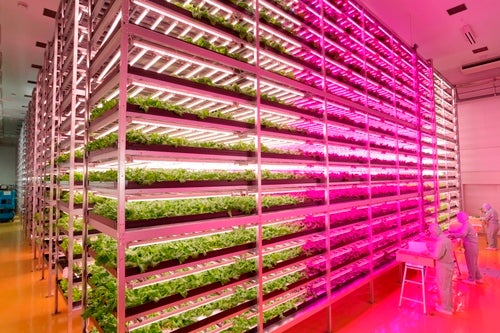Japanese plant experts produce 10,000 lettuce heads a day in LED-lit indoor farm
The LED-powered racks rise 15 levels high and are housed within an old Sony Corp semiconductor factory

Your support helps us to tell the story
From reproductive rights to climate change to Big Tech, The Independent is on the ground when the story is developing. Whether it's investigating the financials of Elon Musk's pro-Trump PAC or producing our latest documentary, 'The A Word', which shines a light on the American women fighting for reproductive rights, we know how important it is to parse out the facts from the messaging.
At such a critical moment in US history, we need reporters on the ground. Your donation allows us to keep sending journalists to speak to both sides of the story.
The Independent is trusted by Americans across the entire political spectrum. And unlike many other quality news outlets, we choose not to lock Americans out of our reporting and analysis with paywalls. We believe quality journalism should be available to everyone, paid for by those who can afford it.
Your support makes all the difference.Could this be the future of agriculture?
A physiologist has turned a former semiconductor factory into one of the world’s largest indoor farm, cultivating lettuces with LED lights.
At almost half the size of a football pitch, the farm, which opened in Japan in July, is already churning out 10,000 lettuce heads a day, the brains behind it say.
Plant physiologist Shigeharu Shimamura wanted to explore ways that man could keep up with the ever-increasing food demand while bypassing the risks brought on by drought, crop disease and natural disasters.
“I knew how to grow good vegetables biologically and I wanted to integrate that knowledge with hardware to make things happen,” Mr Shimamura said.
The climate controlled room is powered by LED fixtures that emit light at wavelengths – the most ideal for plant growth – while also giving the ‘farmers’ power to control the night and day cycles.
The lights were built by American multinational General Electric (GE), which detailed the farm within a self-produced publication.

“What we need to do is not just setting (sic) up more days and nights,” Mr Shimamura added. “We want to achieve the best combination of photosynthesis during the day and breathing at night by controlling the lighting and the environment.”
The lights give them the ability to control temperature, humidity and irrigation, allowing it to cut its water usage to 1 per cent of that needed by outdoor fields, while also growing lettuces two-and-a-half times faster, the experts claim.
The farm comprises of 17,500 LED lights on “18 cultivation racks reaching 15 levels high,” GE says.
The Japan arm of the corporation said it hopes that indoor farms such as this one in the Miyagi Prefecture, which was badly damaged by the powerful earthquake and tsunami in 2011, could solve food shortages in the world.
“Finally, we are about to start the real agricultural industrialization,” Mr Shimamura said.
GE isn’t the only electrical firm trialling the new method. Philips has partnered with Green Sense Farms, an Indiana-based vertical farm which produces herbs, leafy greens and lettuces using LED lights.
Join our commenting forum
Join thought-provoking conversations, follow other Independent readers and see their replies
Comments